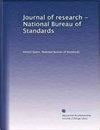Adsorptive Stripping Voltammetry—A New Electroanalytical Avenue for Trace Analysis
Journal of research of the National Bureau of Standards
Pub Date : 1988-05-01
DOI:10.6028/jres.093.130
引用次数: 1
Abstract
nickel can also be determined using a copper anode. Conditions are similar to those for nickel except that the applied potentials must be 200 mV more positive than for nickel. The anodic reaction rate constants with copper are typically somewhat greater than with nickel, however the applied potential results in increased background noise so that copper offers no signal-to-noise advantage over nickel. When the background electrolyte contains nickel as suspended nickel hydroxide as described above, copper, nickel, cobalt, silver, platinum, and gold electrodes yield similar analytical currents. These results indicate that suspended nickel hydroxide adsorbs to the metal electrode surfaces and essentially converts them to nickel oxide electrodes. Silver iodide in its room-temperature crystal form is sufficiently conducting so that it can carry the currents necessary for analytical amperometry. The electrode material is contacted using silver epoxy. The cathodic electrode mechanism involved generation of iodide at the silver:silver iodide interface yielding a current proportional to the rate of oxidation of iodide ions at the silver iodide:solution interface. Hypochlorous acid at sub-parts-per-million level thus yields cathodic currents for pH 6 solutions whereas pH 3 must be used for cathodic amperometry of monochloramine [4]. Accordingly a direct, linear response analytical technique for concentrations from more than 5 mg chlorine per liter down to about 10 gg chlorine per liter was developed for either monochloramine or the sum of hypochlorous acid plus monochloramine. The concentrations determined were sufficiently low to allow determination of the rate constant for monochloramine formation under realistic water treatment concentration, pH, and ionic strength conditions. The rate constant obtained was 3.2X 106 L/mol/s, in agreement with earlier reported values extrapolated from higher concentrations and less moderate pH solutions.吸附溶出伏安法——痕量分析的新电分析途径
镍也可以用铜阳极来测定。条件与镍相似,只是施加的电位必须比镍高200毫伏。与铜的阳极反应速率常数通常比与镍的阳极反应速率常数大一些,然而,应用的潜在结果是背景噪声增加,因此铜没有比镍具有信噪比优势。如上所述,当背景电解质中含有悬浮的氢氧化镍时,铜、镍、钴、银、铂和金电极产生类似的分析电流。这些结果表明,悬浮的氢氧化镍吸附在金属电极表面,并将其转化为氧化镍电极。室温晶体形式的碘化银具有足够的导电性,因此它可以携带分析安培法所必需的电流。电极材料采用银环氧树脂接触。阴极电极机制涉及在银:碘化银界面产生碘化物,产生与碘化银:溶液界面碘化物离子氧化速率成正比的电流。因此,pH为6的次氯酸溶液产生阴极电流,而pH为3必须用于单氯胺[4]的阴极电流测定。因此,对单氯胺或次氯酸加单氯胺的总和,开发了一种直接的线性响应分析技术,其浓度从每升超过5毫克氯到每升约10克氯。测定的浓度足够低,可以在实际的水处理浓度、pH和离子强度条件下测定一氯胺形成的速率常数。得到的速率常数为3.2X 106 L/mol/s,与先前报道的从较高浓度和较不温和的pH溶液中推断出的值一致。
本文章由计算机程序翻译,如有差异,请以英文原文为准。
求助全文
约1分钟内获得全文
求助全文

 求助内容:
求助内容: 应助结果提醒方式:
应助结果提醒方式:


